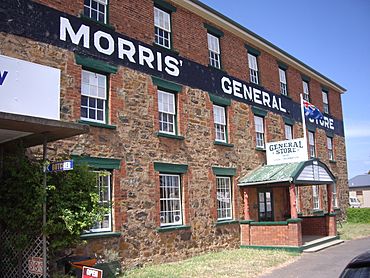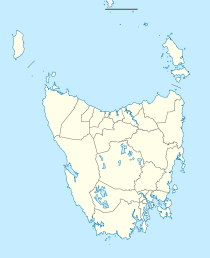Swansea, Tasmania facts for kids
Quick facts for kids SwanseaTasmania |
|||||||||
|---|---|---|---|---|---|---|---|---|---|

Morris' General Store in the main street of Swansea
|
|||||||||
| Population | 997 (2021 census) | ||||||||
| Postcode(s) | 7190 | ||||||||
| Elevation | 11 m (36 ft) | ||||||||
| Location | |||||||||
| LGA(s) | Glamorgan Spring Bay Council | ||||||||
| State electorate(s) | Lyons | ||||||||
| Federal Division(s) | Lyons | ||||||||
|
|||||||||
Swansea is a town on the east coast of Tasmania. It sits on the north-west shore of Great Oyster Bay. From here, you can see Freycinet National Park. It was one of the first towns in Australia to be set up after Hobart and Sydney. In 2021, about 997 people lived in Swansea.
The town was started in 1821. It celebrated its 200th birthday in 2021.
Contents
History of Swansea
The first European to explore the Swansea area was Captain John Henry Cox. He sailed his ship, the Mercury, from England to Sydney. On July 3, 1789, he sailed into a bay he called Oyster Bay. He had heard there were many seals there.
Swansea was settled in 1821. British settlers, led by George Meredith, arrived from Wales. Meredith received permission from Lieutenant Governor William Sorell to farm near Oyster Bay. They grew crops and raised animals. They also built a tannery (where animal hides are made into leather) and a flour mill. Whaling stations were set up on nearby islands. These helped export whale oil.
Swansea was first called Great Swanport. Meredith built his family home, Cambria, which is now a private house. Other important buildings include Morris’ General Store. The Morris family has run it for over 100 years. The Swansea Bark Mill processed black wattle bark. This bark was used to make leather. Today, it is a museum, a pub, and a bakery. Schouten House is a beautiful old house built in 1844. It is now a hotel.
The Waterloo Point Post Office opened in 1832. It was renamed Swansea around 1863.
Famous People from Swansea
- William Lyne: He was a politician who led the state of New South Wales. He was the Premier of New South Wales from 1899 to 1901. Later, he worked as a minister in the Australian government.
- Violet Mace: She was a potter. She was known for her 'proclamation cup'. This cup was based on an important message from Governor Davey's Proclamation.
Wildlife in Swansea
Swansea is home to many animals. You can find colonies of short-tailed shearwaters, also known as muttonbirds. There are also little penguins. The nearby Freycinet National Park has other amazing animals. These include quolls, wallabies, native microbats, possums, and Tasmanian devils. In the ocean nearby, you might see dolphins, whales, and seals.
Climate in Swansea
| Climate data for Swansea | |||||||||||||
|---|---|---|---|---|---|---|---|---|---|---|---|---|---|
| Month | Jan | Feb | Mar | Apr | May | Jun | Jul | Aug | Sep | Oct | Nov | Dec | Year |
| Record high °C (°F) | 40.4 (104.7) |
39.2 (102.6) |
36.8 (98.2) |
30.1 (86.2) |
27.0 (80.6) |
21.1 (70.0) |
24.0 (75.2) |
24.3 (75.7) |
29.6 (85.3) |
33.9 (93.0) |
36.0 (96.8) |
41.1 (106.0) |
41.1 (106.0) |
| Mean daily maximum °C (°F) | 22.2 (72.0) |
22.1 (71.8) |
20.9 (69.6) |
18.6 (65.5) |
15.9 (60.6) |
13.8 (56.8) |
13.3 (55.9) |
14.2 (57.6) |
16.0 (60.8) |
17.7 (63.9) |
19.1 (66.4) |
20.6 (69.1) |
17.9 (64.2) |
| Mean daily minimum °C (°F) | 11.7 (53.1) |
11.8 (53.2) |
10.3 (50.5) |
8.2 (46.8) |
6.2 (43.2) |
4.4 (39.9) |
3.6 (38.5) |
4.4 (39.9) |
5.8 (42.4) |
7.2 (45.0) |
9.0 (48.2) |
10.5 (50.9) |
7.8 (46.0) |
| Record low °C (°F) | 2.4 (36.3) |
1.3 (34.3) |
0.0 (32.0) |
−1.3 (29.7) |
−3.1 (26.4) |
−4.0 (24.8) |
−5.0 (23.0) |
−4.2 (24.4) |
−4.0 (24.8) |
−1.9 (28.6) |
−1.4 (29.5) |
1.0 (33.8) |
−5.0 (23.0) |
| Average precipitation mm (inches) | 49.4 (1.94) |
42.7 (1.68) |
50.4 (1.98) |
51.1 (2.01) |
46.1 (1.81) |
57.5 (2.26) |
47.8 (1.88) |
44.0 (1.73) |
41.1 (1.62) |
53.2 (2.09) |
51.6 (2.03) |
59.9 (2.36) |
594.8 (23.42) |
| Average rainy days | 8.4 | 7.3 | 9.0 | 9.5 | 9.6 | 10.6 | 10.9 | 10.8 | 11.0 | 11.6 | 10.3 | 10.0 | 119.0 |
Population of Swansea
In 1996, a census (a count of all people) showed that 495 people lived in Swansea. About 25.1% of the people were over 65 years old. This made Swansea the town in Tasmania with the most people over 65 at that time.
Images for kids
See also
 In Spanish: Swansea (Tasmania) para niños
In Spanish: Swansea (Tasmania) para niños



